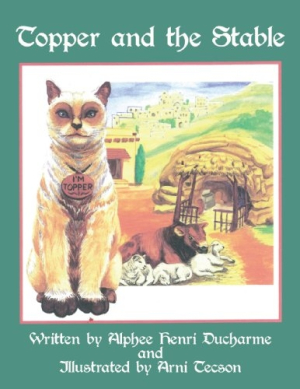Topper and the Stable
Topper and the Stable looks like a children’s book, but it is a Christmas story, above all else, intended for anyone who honors the religious significance of the holiday. The book also offers some innovative additions to a well-known tale.
Author Alphee Henri Ducharme offers four short versions of the first Christmas, all in rhyme. Each version tells the story from the point of view of a different character present at Christ’s birth. Ducharme introduces Topper the cat and Jack the donkey, his own inspired creations, to join the more traditional group gathered at the stable in Bethlehem.
Illustrations by Arni Tecson accompany the text on every page, vividly depicting the people, animals, and action. Some illustrations appear more than once, repeated in the different characters’ versions of the story. Topper, named after the author’s own pet, is a cat with a mission from heaven. He does his part to make the stable safe for Baby Jesus by killing all the rats nearby. Tecson’s illustrations here display a ferocity that may frighten the very young or timid. Topper’s ultimate demise at the hands of some Roman soldiers may also prove too much for a younger audience. Neither Ducharme nor Tecson shy away from the more brutal aspects of the biblical story itself.
Ducharme uses a rhyme scheme that feels forced at times. It also may take readers a while to get used to the meter. He does maintain both admirably, however, although the strain of occasional rhymes, like, “He would be brought forth with heaven’s perfection” paired with “She’d give birth through Immaculate Conception!” can be painful. The meter also suffers when stressed syllables are out of balance, as when, “The Mother sang for the Child. We brought them food,” is rhymed with, “Soon things would occur to change this peaceful mood!” Nonetheless, Ducharme deserves credit for consistently following his format for more than one-hundred stanzas, by and large, successfully.
Although told four different times by four very different characters, the basic story does not vary widely from one telling to the next. Strict traditionalists may question certain details, such as the timing of the arrival of the Magi, or the very presence of a cat who wears a name tag and becomes an angel, but Ducharme’s interpretation does not challenge the legend of the first Christmas as most have come to know it. Instead, both Ducharme and Tecson provide perspectives that others may not have considered.
For example, few ever ask how the innkeeper and his wife felt about the use of their stable, and only a child might wonder how Joseph’s donkey perceived his role in the proceedings. Add to that the actions and observations of a little cat who may simply have been overlooked, and the story is seen—and told— through new eyes.
Much like a Sunday School production of the Nativity play, Topper and the Stable is the Christmas story with a little twist. The book would make a superb holiday gift for a Christian family, or a fine addition to a treasured collection of Christmas literature.
Reviewed by
Cheryl Hibbard
Disclosure: This article is not an endorsement, but a review. The publisher of this book provided free copies of the book and paid a small fee to have their book reviewed by a professional reviewer. Foreword Reviews and Clarion Reviews make no guarantee that the publisher will receive a positive review. Foreword Magazine, Inc. is disclosing this in accordance with the Federal Trade Commission’s 16 CFR, Part 255.

